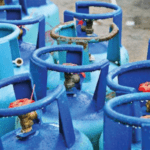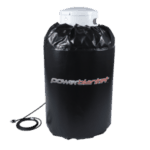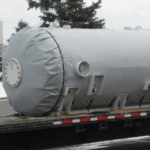When grilling in the backyard, do you wonder how long does a small propane tank last on a grill?
Homeowners and businesses are alike. If they rely on propane, they have the same question about how long a propane tank should last. Imagine your production halting in the middle of an operation or taking a shower with ice-cold water in the winter because the propane ran out. Knowing the average propane gas consumption for better planning, budgeting, and reordering in time is important.
Other valid questions concerning the propane tank life are: how long can you use a propane tank, and how many years does a propane tank last?
This article will show you the different factors that impact propane consumption, the propane tank lifespan, and a few suggestions for keeping the propane fuel tank in good shape.
Propane is an essential fuel for households and businesses. Monitoring your propane levels is crucial to avoid disruptions, especially when cold weather can slow down or even stop your propane flow in its tracks. Our propane tank heaters allow you to monitor tank levels remotely and receive alerts when it’s time to refill. Enjoy peace of mind, knowing your propane keeps flowing no matter how cold it gets.
Understanding Tank Sizes
The smallest residential propane tank in the market is the 20-pound barbeque tank. The empty tank weighs about 20 pounds and holds 4.6 gallons of propane.
The next propane tank size up is the 100 lb. tank, which holds approximately 23.6 gallons. At 4.2 pounds per gallon, the tank holds 99.12 pounds of propane. They are relatively light and can move to other locations depending on the need, such as drying drywall in new construction.
The remaining tank sizes are large stationary propane tanks. Here are their specifications:
- 120-gallon tank – It’s also called a “420” tank because it holds 100 gallons or 420 lb. of propane. They are the right size for a supplemental gas fireplace. Installing two tanks together is a low-profile heat source for a home and an alternative to a larger horizontal tank.
- 300-gallon (underground) – This model is narrower and longer than above-ground tanks. Underground tanks are best for propane stoves, propane furnaces, and water heating systems. Only the filler valve and gauge extend above ground for a cleaner look.
- 500-gallon – Restaurants and light industrial applications that require a larger propane supply use this tank. There are above-ground and underground models.
- 1,000-gallon (Underground) – Underground tanks must be 10 feet from the home, property line, and electrical ignition source.
Most suppliers can install a wireless electronic meter that monitors how much propane remains in the tank. It can schedule an automatic propane delivery at the right time to avoid service interruptions. Homeowners can purchase Wi-Fi or GSM Cellular propane tank monitors that notify them when the fuel tank is low.
Typical Propane Home Usage Factors
There are three primary uses for propane as a heat source. Here are typical usage or burn rates for each.
1. Recreational Grilling
Anyone who owns a backyard gas barbeque grill uses the 20-pound tank. Typically, one 20-lb. propane tank lasts between 18 to 20 hours on a medium-sized grill. Larger grills with multiple burners can go through 20 pounds of propane in as little as 10 hours.
We can break it down another way. Using the highest setting, cooking on a medium-sized grill will consume 1 to 2 pounds of fuel per grilling session. That’s the equivalent of 8 meals per tank.
2. Home Furnaces
The heating industry measures heat output as BTUs or British Thermal Units. The furnace for an average single-family unit puts out approximately 100,000 BTUs per hour. A gallon of propane produces about 92,000 BTUs. That means a propane-powered furnace uses about one gallon of propane per hour during the heating season. Depending on the season and personal preference, a home can burn between 500 and 1,200 gallons of propane during the winter months.
3. Hot Water Heaters
Hot water usage depends on variables like the number of people in the home, the number of bathrooms, and how long people take a shower. The average house burns 1.5 gallons of propane per day just for the water heater. Using that average consumption rate, homeowners will burn 200 to 300 gallons of propane per year to heat water.
Combining heating and hot water, the propane consumption for the average homeowner is about two and a half 500-gallon tanks per year.
Next, we’ll show you how to calculate propane gas consumption to help you determine the correct tank size and budget.
Calculating Consumption or “Burn Rate” of Propane
This calculation can help answer the question, how many hours does a propane tank last?
- First, find the tank’s tare or empty weight. It’s usually a number stamped on the tank’s collar.
- Next, weigh the tank with the fuel.
- Subtract the tare weight to find the weight of the propane.
- Divide the total weight of your fuel by 4.24 to determine the gallons. Use 4.24 pounds of propane = one gallon.
Let’s look at an example.
Your gas grill or other appliance will provide an estimated burn rate measured in BTUs. Use this formula to calculate the burn rate:
BTUs per gallon/BTU burn rate of the appliance = hours of burn time
The calculation is 92,000 BTUs per gallon of propane/60,000 BTUs (the burn rate of the appliance) = 1.53 hours.
If the grill uses 60,000 BTUs per hour, 1 gallon of propane will last about 1.5 hours.
If you know the weight of fuel left in the tank, you can convert it to gallons and then divide the total gallons by the hourly burn rate of your appliance. This figure will give an accurate answer to the question of how many hours a propane tank will last and the fuel you have left.
Some Propane Tank FAQs
Here are the questions people ask most often regarding propane tanks:
How long will 20 lb. propane tank last?
There are two variables in barbeque gas grills: the burners’ size and how high you set the grill. A 20-lb. tank will last from 10 to 20 hours of cooking, depending on the chef and the grill.
How long does a 500-gallon propane tank last?
Based on U.S. Energy Information Administration figures, the average household consumption of propane is 750 gallons during the winter heating months of October to March. Using that figure means an average home requires about 2 full 500-gallon propane tanks per winter. Keep in mind that tanks are “full” at 80% of their stated capacity. Suppliers can only fill a 500-gallon tank to 400 gallons of propane for safety requirements.
Installing a propane tank heater is one way to get more out of your tank and prevent freezing during the harshest weather.
How do you know when to replace your propane tank?
Stationary propane tanks can last for decades with proper maintenance (See Below). They must be recertified after 10 years from the manufacturing date, then every five years.
How often does a propane tank need to be filled?
Modern permanent propane tanks have an electronic monitor that notifies the supplier when to refill before the tank runs out. If your tank doesn’t have this feature, you’ll need to monitor the tank’s gauge physically. It’s best to order between 20 to 10% of the tank’s capacity.
How often depends upon individual consumption. A commercial kitchen cooking with propane will run through a tank much faster than a homeowner’s.
How long can propane sit in a tank before it goes bad?
Propane is a hydrocarbon molecule, C3H8, and a by-product of natural gas processing and crude oil refining. It’s called liquefied petroleum gas, LP-gas, and LPG. Unlike gasoline, it doesn’t degrade or go bad.
How long does a propane tank last for a house?
As we mentioned above, an average home requires 2 to 2.5 500-gallon tanks per winter heating season. Variables include the number of bathrooms, people, and gas appliances such as fireplaces and clothes dryers.
If we’re talking about steel tanks, they can last for 30 years with proper care and maintenance.
Industrial and Commercial Propane Tanks
Industrial high-volume propane usage includes commercial kitchens, fleet fueling, agricultural heating, forklift refueling, and propane reselling. Some commercial users measure their consumption in gallons per minute instead of gallons per hour.
Commercial tanks will have 500 to 1,000-gallon capacity and can have multiple tanks hooked together in a series for continuous flow. How long will a propane tank last under commercial conditions depends on the hourly consumption.
Unlike a home, commercial users require a steady flow rate of up to 24 hours per day, depending on the operation.
For example, a load of 1 million BTUs requires 11 gallons per hour. For a 10-hour shift, that’s 110 gallons per day. The business should have at least a 2,000-gallon storage capacity.
Proper Vaporization Requires Heat
Cold weather can make maintaining optimal pressure in gas cylinders very difficult. Freezing temperatures prevent the gas from vaporizing efficiently. In some cases, it makes the gas cylinders unusable.
Commercial and home propane users need the gas delivered as a vapor, not liquified. To help the process, installing propane tank heaters keeps the propane in the tank at a constant temperature and pressure. Tank heaters are one of the best industrial heating solutions, and they can also prevent valves and regulators from freezing during the winter months.
Proper Propane Tank Maintenance
How long do propane tanks last? The propane tank lifespan can be up to 30 years, but the 20 lb. propane tank lifespan is less due to the damage from constant handling. It’s all about safety. Tanks must be inspected and recertified after ten years from the manufacturing date and every five years.
Whether you are inspecting a 20-lb. tank or a 1,000-gallon tank, you want to check for the following issues:
- Ensure that the paint is intact and that there is no corrosion.
- Check for leaks around valves or other connections
- Ensure that the tank sits on a stable and level platform where there is no danger of tipping over.
- Look for damaged gauges or valves
- Any kinks in the gas line or dents to the tank
- Soot accumulation around appliance burners indicates that the gas isn’t operating properly.
- Proper ventilation
Propane is heavier than air. Burning propane produces Carbon Monoxide (CO), so all propane equipment and appliances must have proper ventilation.
If you find a problem with any component of the propane system, only use a qualified professional for propane tank maintenance or repairs.
Keep your propane tanks at the perfect pressure with Powerblanket.





